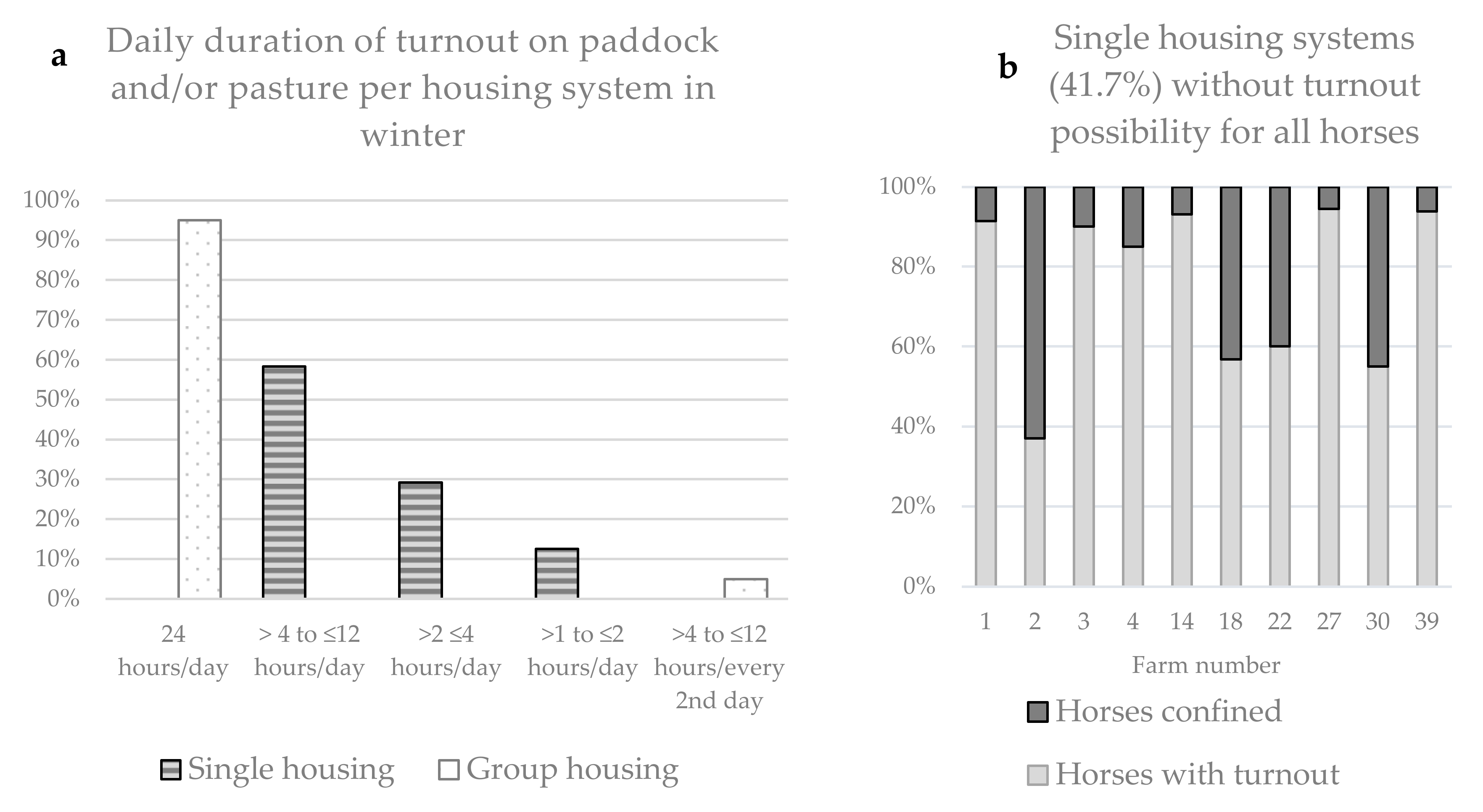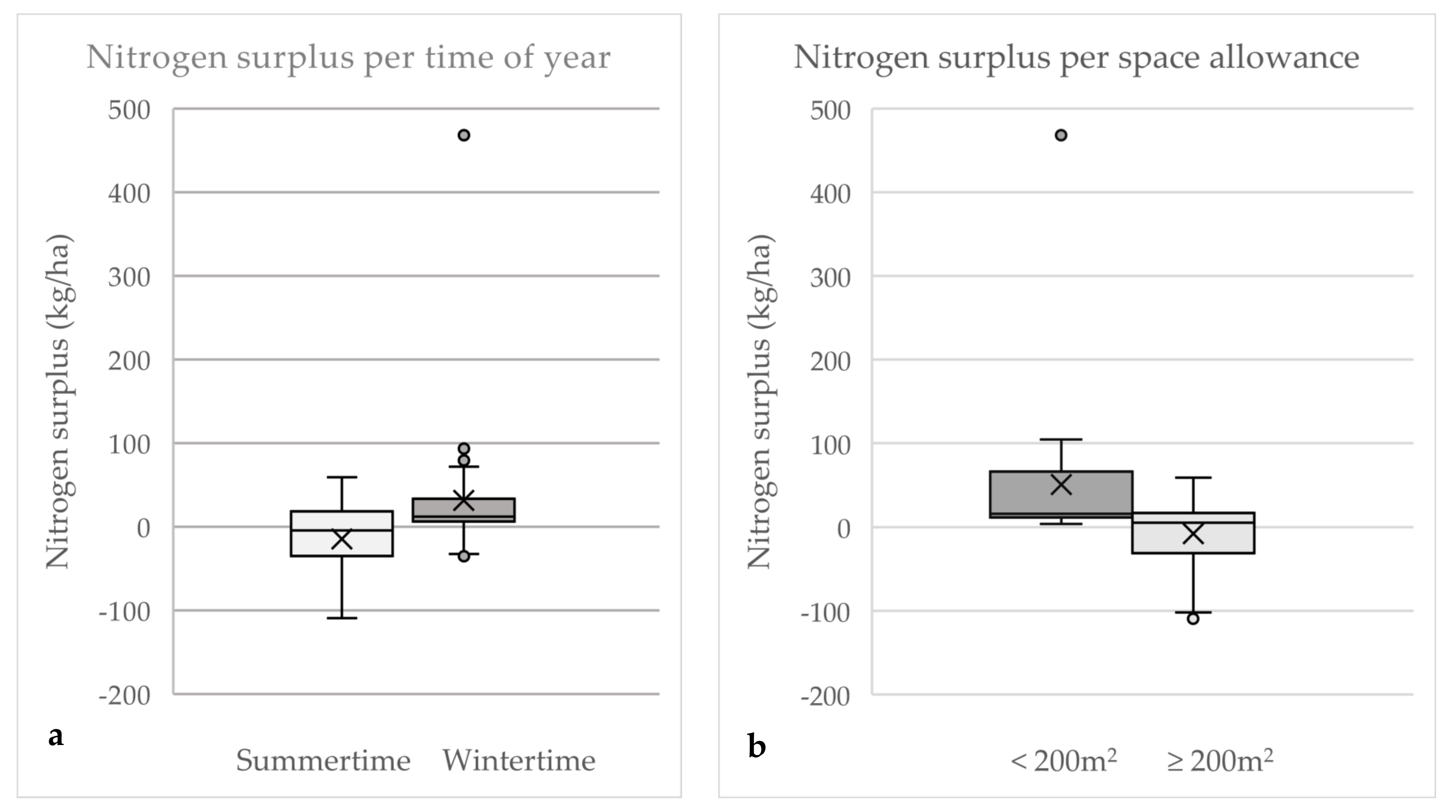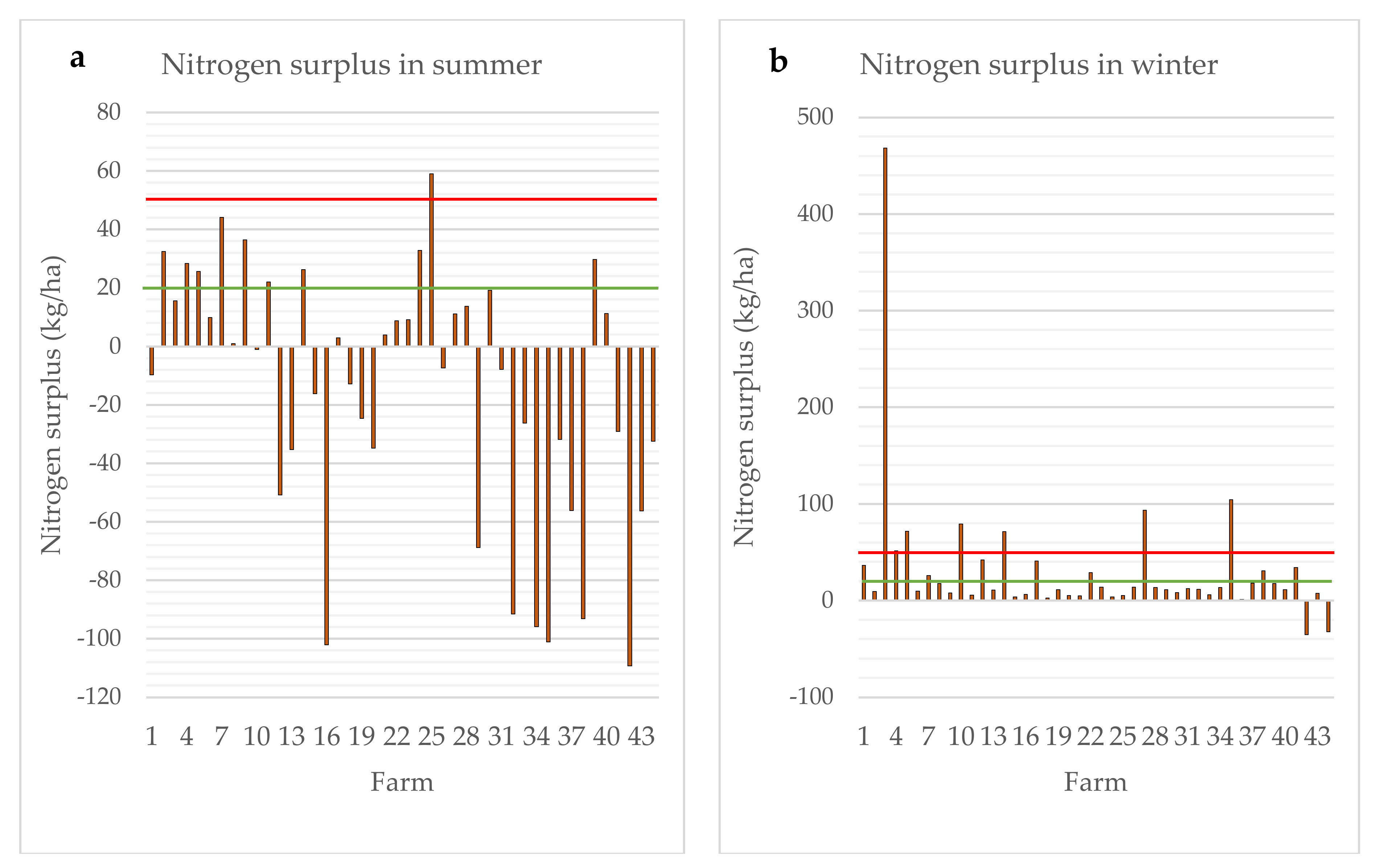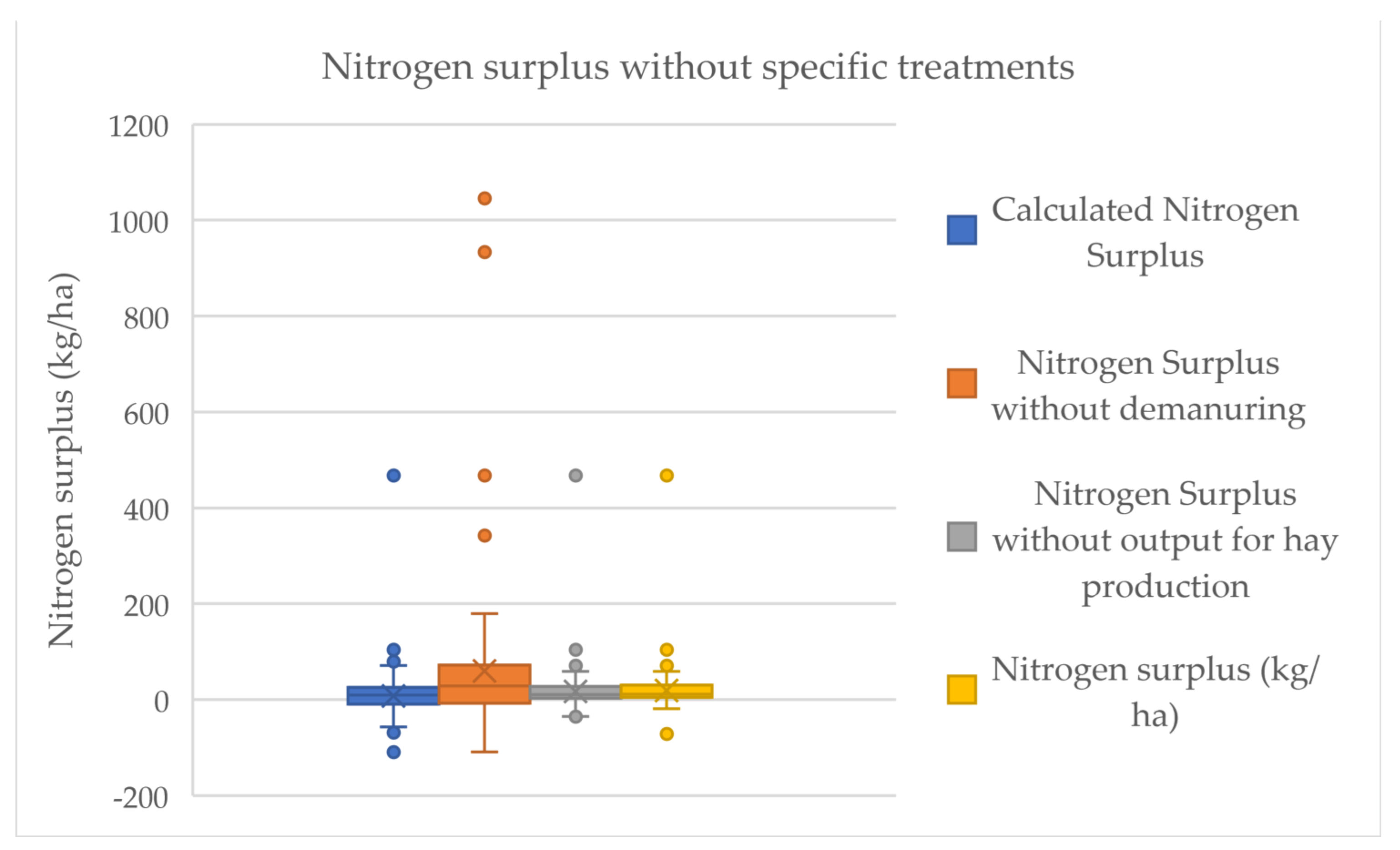Improving Horse Welfare and Environmental Sustainability in Horse Husbandry: Linkage between Turnout and Nitrogen Surplus
Abstract
1. Introduction
1.1. Relevance and Linkage of Horse Welfare and Environmental Effects in Horse Husbandry
1.2. Environmental Relevance of Nitrogen Surplus
1.3. Animal Welfare Assessment with a Focus on Horses
1.4. Turnout as a Welfare Concern
1.5. Aim of the Work
2. Materials and Methods
2.1. Data Collection
2.2. Assessment of Turnout
2.3. Calculation of Nitrogen Surplus
2.4. Statistical Analysis
2.5. Ethics Statement
3. Results
3.1. Turnout
3.2. Nitrogen Surplus
4. Discussion
4.1. Turnout
4.2. Nitrogen Surplus and the Linkage to “Turnout”
5. Conclusions
Author Contributions
Funding
Institutional Review Board Statement
Informed Consent Statement
Data Availability Statement
Acknowledgments
Conflicts of Interest
References
- Deutscher Ethikrat. Tierwohlachtung–Zum verantwortlichen Umgang mit Nutztieren. In Stellugnnahme; Deutscher Ethikrat: Berlin, Germany, 2020. [Google Scholar]
- FN. Wie pferdegerecht sind Ausbildung, Turniersport und Pferdehaltung in Deutschland? In Online-Umfrage (fn-Press) der Deutschen Reiterlichen Vereinigung e.V. (FN), Warendorf. 2016. Available online: https://www.ipzv.de/newsdetail-kurzmeldungen/fn-umfrage-zu-ausbildung-turniersport-und-pferdehaltung.html (accessed on 9 August 2021).
- Winkel, C.; Schukat, S.; Heise, H. Importance and Feasibility of Animal Welfare Measures from a Consumer Perspective in Germany. Food Ethics 2020, 5, 21. [Google Scholar] [CrossRef]
- Horseman, S.V.; Buller, H.; Mullan, S.; Whay, H.R. Current Welfare Problems Facing Horses in Great Britain as Identified by Equine Stakeholders. PLoS ONE 2016, 11, e0160269. [Google Scholar] [CrossRef] [PubMed]
- Dalla Costa, E.; Dai, F.; Lebelt, D.; Scholz, P.; Barbieri, S.; Canali, E.; Minero, M. Initial outcomes of a harmonized approach to collect welfare data in sport and leisure horses. Animal 2017, 11, 254–260. [Google Scholar] [CrossRef]
- Sarrafchi, A.; Blokhuis, H.J. Equine stereotypic behaviors: Causation, occurrence, and prevention. J. Vet. Behav. 2013, 8, 386–394. [Google Scholar] [CrossRef]
- D’Ingeo, S.; Quaranta, A.; Siniscalchi, M.; Stomp, M.; Coste, C.; Bagnard, C.; Hausberger, M.; Cousillas, H. Horses associate individual human voices with the valence of past interactions: A behavioural and electrophysiological study. Sci. Rep. 2019, 9, 11568. [Google Scholar] [CrossRef] [PubMed]
- Ruet, A.; Lemarchand, J.; Parias, C.; Mach, N.; Moisan, M.-P.; Foury, A.; Briant, C.; Lansade, L. Housing Horses in Individual Boxes Is a Challenge with Regard to Welfare. Animals 2019, 9, 621. [Google Scholar] [CrossRef]
- Hausberger, M.; Lerch, N.; Guilbaud, E.; Stomp, M.; Grandgeorge, M.; Henry, S.; Lesimple, C. On-Farm Welfare Assessment of Horses: The Risks of Putting the Cart before the Horse. Animals 2020, 10, 371. [Google Scholar] [CrossRef]
- Schmitz, A.; Isselstein, J. Effect of Grazing System on Grassland Plant Species Richness and Vegetation Characteristics: Comparing Horse and Cattle Grazing. Sustainability 2020, 12, 3300. [Google Scholar] [CrossRef]
- United Nations. Tansforming our world: The 2030 Agenda for Sustainable Development. Seventieth session Agenda items 15 and 116. In Proceedings of the 2030 Agenda for Sustainable Development, New York, NY, USA, 25–27 September 2015; pp. 1–35. Available online: https://sdgs.un.org/2030agenda (accessed on 9 August 2021).
- Buchgraber, K.; Braach, J.; Münsch, C. Stickstoffanfall Bei Pferden Auf Gatschkoppeln und dessen Umweltrelevanz. In Gülle 11-Gülle-und Gärrestdüngung auf Grünland; Elsäßer, M., Diepolder, M., Huguenin-Elie, O., Pötsch, E., Nußbaum, H., Messner, J., Eds.; Kloster Reute, Landwirtschaftliches Zentrum Baden-Württemberg (LAZBW): Württemberg, Germany, 2011. [Google Scholar]
- Bomans, K.; Dewaelheyns, V.; Gulinck, H. Pasture for horses: An underestimated land use class in an urbanized and multifunctional area. Int. J. SDP 2011, 6, 195–211. [Google Scholar] [CrossRef]
- Zasada, I.; Berges, R.; Hilgendorf, J.; Piorr, A. Horsekeeping and the peri-urban development in the Berlin Metropolitan Region. J. Land Use Sci. 2013, 8, 199–214. [Google Scholar] [CrossRef]
- Buchgraber, K.; Braach, J.; Münsch, C.; Erasimus, L.; Feichtinger, F.; Dorner, J.; Konheisner, G. Pferde auf Gatschkoppeln. In Der fortschrittliche Landwirt-Fachzeitschrift für die Bäuerliche Familie-Sonderbeilage Pferd Plus; Stocker-Verlag: Graz, Austria, 2011; pp. 1–12. [Google Scholar]
- Buchgraber, K.; Braach, J.; Münsch, C.; Erasimus, L.; Feichtinger, F.; Dorner, J.; Konheisner, G. Calculations are correct: Successful management coupling reduces the nitrate contamination and protects the groundwater (Richtig gerechnet-Erfolgreiches Koppelmanagement mindert die Nitratbelastung und schützt das Grundwasser). Pferdefokus 2012, 3, 30–34. [Google Scholar]
- Hölker, S.; Wiegand, K.; Münch, C.; Spiller, A. Georg-August-Universität Göttingen. Lehrstuhl, Marketing für Lebensmittel und Agrarprodukte. In Pferdehaltung Heute: Eine Strukturdatenerfassung Pferdehaltender Betriebe in Deutschland; HorseFuturePanel UG: Göttingen, Germany, 2017. [Google Scholar]
- Council Directive Concerning the Protection of Waters Against Pollution Caused by Nitrates from Agricultural Sources (the Nitrates Directive); EEC: Brussels, Belgium, 1991.
- Schullehner, J.; Hansen, B.; Thygesen, M.; Pedersen, C.B.; Sigsgaard, T. Nitrate in drinking water and colorectal cancer risk: A nationwide population-based cohort study. Int. J. Cancer 2018, 143, 73–79. [Google Scholar] [CrossRef]
- Groundwater Protection in Europe—The New Groundwater Directive–Consolidating the Eu Regulatory Framework: The Groundwater Directive 2006/118/EC; European Commission: Luxembourg, 2008.
- Richtlinie für die Sachgerechte Düngung im Ackerbau und im Grünland-Anleitung zur Interpretation von Bodenuntersuchungsergebnissen in der Landwirtschaft (SAG), 7th ed.; Bundesministerium für Land- und Forstwirtschaft, Umwelt und Wasserwirtschaft: Vienna, Austria, 2017.
- Verordnung über die Anwendung von Düngemitteln, Bodenhilfsstoffen, Kultursubstraten und Pflanzenhilfsmitteln nach den Grundsätzen der guten fachlichen Praxis beim Düngen: Düngeverordnung-DüV; Bundesministeriums der Justiz und für Verbraucherschutz: Berlin, Germany, 2017.
- Küstermann, B.; Christen, O.; Hülsbergen, K.-J. Modelling nitrogen cycles of farming systems as basis of site-and farm-specific nitrogen management. Agric. Ecosyst. Environ. 2010, 135, 70–80. [Google Scholar] [CrossRef]
- Broom, D.M. Indicators of poor welfare. Br. Vet. J. 1986, 142, 524–526. [Google Scholar] [CrossRef]
- Tarazona, A.M.; Ceballos, M.C.; Broom, D.M. Human Relationships with Domestic and Other Animals: One Health, One Welfare, One Biology. Animals 2019, 10, 43. [Google Scholar] [CrossRef]
- Minero, M.; Dalla Costa, E.; Dai, F. AWIN Welfare Assessment Protocol for Horses; AWIN: Edinburgh, UK, 2015. [Google Scholar] [CrossRef]
- Dalla Costa, E.; Murray, L.; Dai, F.; Canali, E.; Minero, M. Equine on-farm welfare assessment: A review of animal-based indicators. Anim. Welf. 2014, 23, 323–341. [Google Scholar] [CrossRef]
- Viksten, S.M. Improving Horse Welfare through Assessment and Feedback. Ph.D. Thesis, Swedish University of Agricultural Sciences, Uppsala, Sweden, 2016. [Google Scholar]
- Viksten, S.M.; Visser, E.K.; Nyman, S.; Blokhuis, H.J. Developing a horse welfare assessment protocol. Anim. Welf. 2017, 26, 59–65. [Google Scholar] [CrossRef]
- Graham-Thiers, P.M.; Bowen, L.K. Improved Ability to Maintain Fitness in Horses During Large Pasture Turnout. J. Equine Vet. Sci. 2013, 33, 581–585. [Google Scholar] [CrossRef]
- Safran, M.R.; Garrett, W.E.; Seaber, A.V.; Glisson, R.R.; Ribbeck, B.M. The role of warmup in muscular injury prevention. Am. J. Sports Med. 1988, 16, 123–129. [Google Scholar] [CrossRef]
- Wilke, A. Effects of Rearing Conditions and Growth Rates on the Development of Osteochondrosis (OC) in Riding Horses; Tierärztliche Hochschule Hannover: Hannover, Germany, 2003. [Google Scholar]
- Gygax, L. Wanting, liking and welfare: The role of affective states in proximate control of behaviour in vertebrates. Ethology 2017, 123, 689–704. [Google Scholar] [CrossRef]
- Metz-Göckel, H. "need" (Bedürfnis) in Dorsch Lexikon der Psychologie, 19th ed.; Wirtz, M.A., Ed.; Hogrefe Verlag GmbH & Co. KG: Göttingen, Germany, 2020; Available online: https://dorsch.hogrefe.com/stichwort/beduerfnis/ (accessed on 10 August 2021).
- Zeitler-Feicht, M.H. Horse Behaviour Explained: Origins, Treatment and Prevention of Problems, 1st ed.; Manson Publishing: London, UK, 2004. [Google Scholar]
- Würbel, H.; Bergeron, R.; Cabib, S. The Coping Hypothesis of Stereotypic Behaviour. In Stereotypic animal behaviour, Fundamentals and Applications to Welfare; Mason, G., Rushen, J., Eds.; CABI Publishing: Wallingford, UK, 2006. [Google Scholar]
- Hockenhull, J.; Creighton, E. The day-to-day management of UK leisure horses and the prevalence of owner-reported stable-related and handling behaviour problems. Anim. Welf. 2015, 24, 29–36. [Google Scholar] [CrossRef]
- Lesimple, C.; Fureix, C.; LeScolan, N.; Richard-Yris, M.-A.; Hausberger, M. Housing conditions and breed are associated with emotionality and cognitive abilities in riding school horses. Appl. Anim. Behav. Sci. 2011, 129, 92–99. [Google Scholar] [CrossRef]
- Christensen, J.W.; Ladewig, J.; Søndergaard, E.; Malmkvist, J. Effects of individual versus group stabling on social behaviour in domestic stallions. Appl. Anim. Behav. Sci. 2002, 75, 233–248. [Google Scholar] [CrossRef]
- Baumgartner, M.; Boisson, T.; Erhard, M.H.; Zeitler-Feicht, M.H. Common Feeding Practices Pose A Risk to the Welfare of Horses When Kept on Non-Edible Bedding. Animals 2020, 10, 411. [Google Scholar] [CrossRef] [PubMed]
- Chaplin, S.J.; Gretgrix, L. Effect of housing conditions on activity and lying behaviour of horses. Animal 2010, 4, 792–795. [Google Scholar] [CrossRef] [PubMed]
- Chaya, L.; Cowan, E.; McGuire, B. A note on the relationship between time spent in turnout and behaviour during turnout in horses (Equus caballus). Appl. Anim. Behav. Sci. 2006, 98, 155–160. [Google Scholar] [CrossRef]
- Freire, R.; Buckley, P.; Cooper, J.J. Effects of different forms of exercise on post inhibitory rebound and unwanted behaviour in stabled horses. Equine Vet. J. 2009, 41, 487–492. [Google Scholar] [CrossRef]
- Jørgensen, G.H.M.; Bøe, K.E. A note on the effect of daily exercise and paddock size on the behaviour of domestic horses (Equus caballus). Appl. Anim. Behav. Sci. 2007, 107, 166–173. [Google Scholar] [CrossRef]
- Stachurska, A.; Różańska-Boczula, M.; Wnuk-Pawlak, E. The difference in the locomotor activity of horses during solitary and paired release: Unterschiede der lokomotorischen Aktivität von Pferden während des Auslaufs alleine und paarweise. Pferdeheilkunde Equine Med. 2021, 37, 50–55. [Google Scholar] [CrossRef]
- Mach, N.; Lansade, L.; Bars-Cortina, D.; Dhorne-Pollet, S.; Foury, A.; Moisan, M.-P.; Ruet, A. Gut microbiota resilience in horse athletes following holidays out to pasture. Sci. Rep. 2021, 11, 5007. [Google Scholar] [CrossRef]
- GFFA. Guidelines for Good Animal Welfare Practice for the Keeping of Horses (Leitlinien zur Beurteilung von Pferdehaltungen unter Tierschutzgesichtspunkten), 2nd ed.; German Federal Ministry of Food and Agriculture (Bundesministerium für Ernährung und Landwirtschaft): Berlin, Germany, 2009. [Google Scholar]
- Schmitz, A.; Isselstein, J. Wieviel Grünland wird in Deutschland für Pferde genutzt? Versuch einer Quantifizierung anhand von Bestands- und Praxisdaten. In Berichte über Landwirtschaft-Zeitschrift für Agrarpolitik und Landwirtschaft; German Federal Ministry of Food and Agriculture (Bundesministerium für Ernährung und Landwirtschaft): Berlin, Germany, 2018. [Google Scholar]
- RStudio Team. RStudio: Integrated Development for R; RStudio, PBC: Boston, MA, USA, 2020; Available online: http://www.rstudio.com/ (accessed on 10 August 2021).
- Siebrecht, N. Sustainable Agriculture and Its Implementation Gap—Overcoming Obstacles to Implementation. Sustainability 2020, 12, 3853. [Google Scholar] [CrossRef]
- Jouven, M.; Vial, C.; Fleurance, G. Horses and rangelands: Perspectives in Europe based on a French case study. Grass Forage. Sci. 2016, 71, 178–194. [Google Scholar] [CrossRef]
- FN. Zahlen & Fakten aus Pferdesport und Pferdezucht: Wirtschaftsfaktor Pferd. Available online: https://www.pferd-aktuell.de/deutsche-reiterliche-vereinigung/zahlen--fakten (accessed on 10 August 2021).
- Eisler, M.C.; Lee, M.R.F.; Tarlton, J.F.; Martin, G.B.; Beddington, J.; Dungait, J.A.J.; Greathead, H.; Liu, J.; Mathew, S.; Miller, H.; et al. Agriculture: Steps to sustainable livestock. Nature 2014, 507, 32–34. [Google Scholar] [CrossRef]
- Kroebel, R.; Stephens, E.; Gorzelak, M.; Thivierge, M.-N.; Akhter, F.; Nyiraneza, J.; Singer, S.; Geddes, C.M.; Glenn, A.; Devillers, N.; et al. Making farming more sustainable by helping farmers to decide rather than telling them what to do. Environ. Res. Lett. 2021, 16, 055033. [Google Scholar] [CrossRef]
- TierSchG: Tierschutzgesetz in der Fassung der Bekanntmachung Vom 18. Mai 2006 (BGBl. I S. 1206, 1313), zuletzt durch Artikel 1 des Gesetzes vom 18. Juni 2021 (BGBl. I S. 1828) Geändert; Bundesministeriums der Justiz und für Verbraucherschutz: Berlin, Germany, 2021. [Google Scholar]
- Tierschutzgesetz Kommentar: Mit TierSchHundeV, TierSchNutztV, TierSchVersV, TierSchTrV, EU-Tiertransport-VO, TierSchlV, EU-Tierschlacht-VO; Auflage, H.A., Maisack, C., Moritz, J., Eds.; Vahlen, Franz: München, Germany, 2016; ISBN 9783800662388. [Google Scholar]
- Düpjan, S.; Puppe, B. Abnormal behaviour with a focus on stereotypies–indicators of suffering and impaired welfare? (Abnormales Verhalten mit dem Schwerpunkt Stereotypien–Indikator für Leiden und beeinträchtigtes Wohlbefinden?). KG Berl Münch Tierärztl Wochenschr 2016, 93–102. [Google Scholar] [CrossRef]
- Henderson, A.J.Z. Don’t fence me in: Managing psychological well being for elite performance horses. J. Appl. Anim. Welf. Sci. 2007, 10, 309–329. [Google Scholar] [CrossRef] [PubMed]
- Schmitz, A.; Tonn, B.; Schöppner, A.-K.; Isselstein, J. Using a Citizen Science Approach with German Horse Owners to Study the Locomotion Behaviour of Horses on Pasture. Sustainability 2020, 12, 1835. [Google Scholar] [CrossRef]
- Flauger, B.; Krueger, K. Aggression level and enclosure size in horses (Equus caballus). Pferdeheilkunde Equine Med. 2013, 29, 495–504. [Google Scholar] [CrossRef][Green Version]




| Trial | Farms (n) 1 | Replicates (n) | Horses (n) | Assessors (n) | Assessments in Total (n) |
|---|---|---|---|---|---|
| 1 | 12 (6 G + 6 S) | 4 | 685 | 3 | 48 |
| 2 | 18 (9 G + 9 S) | 1 | 887 | 1 | 18 |
| 3 | 2 (1 G + 1 S) | 4 | 32 | 1 | 8 |
| 4 | 14 (5 G + 9 S) | 1 | 616 | 1 | 14 |
| Sum | 46 (21 G + 25 S) | 1–4 | 2220 | 1–3 | 88 |
| Symbol | Description |
|---|---|
| HN | Number of horses |
| DW/S | Days per year on summer (S) or winter (W) turnout area |
| NE | Nitrogen (N) excretions in grams per horse and day (values Table 3) |
| AF | Area factor calculated by 1/ha of the available turnout area |
| DF | Demanuring factor: 0.1 for daily demanuring (equivalent to 90% N output) 0.3 for weekly demanuring (equivalent to 70% N output) |
| SF | Sowing factor (seeding pastures afterperiods of turnout which leads to N output from the soil into the gras): 38 kg N per hectare |
| HP | N output for additional hay production on turnout area: 77 kg N per hectare |
| Type and Daily Duration of Turnout | Nitrogen Excretions (Feces + Urine) in Grams per Horse and Day |
|---|---|
| Pasture (separate) 1 for 2 h | 7.2 |
| Pasture (separate) 1 for 3 h | 10.8 |
| Pasture (separate) 1 for 4 h | 14.4 |
| Pasture (separate) 1 for 5 h | 19.2 |
| Pasture (separate) 1 for 6–24 h | 24.0 |
| Free-range stable all day 2 | 7.1 |
| Mud paddock (separate) 3, several hours (not specified) | 7.2 |
| Descriptive Value | Summer | Winter | Group Housing | Single Housing | Space Allowance < 200 m2 | Space Allowance ≥ 200 m2 |
|---|---|---|---|---|---|---|
| Mean | −14.81 | 31.22 | −5.30 | 19.46 | 50.59 | −7.69 |
| Median | −4.24 | 12.01 | 5.35 | 11.25 | 15.71 | 5.08 |
| Minimum | −109.27 | −35.19 | −109.27 | −102.08 | 3.65 | −109.27 |
| Maximum | 58.97 | 468.00 | 79.06 | 468.00 | 468.00 | 58.97 |
| Time of Year | Good: ≤20 kg | Moderate: >20 kg to <50 kg | Poor: ≥50 kg |
|---|---|---|---|
| summertime | 31 | 10 | 3 |
| wintertime | 30 | 7 | 7 |
| Descriptive Value | Calculated Nitrogen Surplus | Nitrogen Surplus without Demanuring | Nitrogen Surplus without Output for Hay Production | Nitrogen Surplus without Output for Sowing |
|---|---|---|---|---|
| Mean | 8.20 | 60.35 | 17.65 | 19.09 |
| Median | 9.70 | 28.60 | 11.16 | 12.05 |
| Minimum | −109.27 | −109.27 | −35.27 | −71.27 |
| Maximum | 468.00 | 1045.16 | 468.00 | 468.00 |
Publisher’s Note: MDPI stays neutral with regard to jurisdictional claims in published maps and institutional affiliations. |
© 2021 by the authors. Licensee MDPI, Basel, Switzerland. This article is an open access article distributed under the terms and conditions of the Creative Commons Attribution (CC BY) license (https://creativecommons.org/licenses/by/4.0/).
Share and Cite
Baumgartner, M.; Kuhnke, S.; Hülsbergen, K.-J.; Erhard, M.H.; Zeitler-Feicht, M.H. Improving Horse Welfare and Environmental Sustainability in Horse Husbandry: Linkage between Turnout and Nitrogen Surplus. Sustainability 2021, 13, 8991. https://doi.org/10.3390/su13168991
Baumgartner M, Kuhnke S, Hülsbergen K-J, Erhard MH, Zeitler-Feicht MH. Improving Horse Welfare and Environmental Sustainability in Horse Husbandry: Linkage between Turnout and Nitrogen Surplus. Sustainability. 2021; 13(16):8991. https://doi.org/10.3390/su13168991
Chicago/Turabian StyleBaumgartner, Miriam, Sandra Kuhnke, Kurt-Jürgen Hülsbergen, Michael H. Erhard, and Margit H. Zeitler-Feicht. 2021. "Improving Horse Welfare and Environmental Sustainability in Horse Husbandry: Linkage between Turnout and Nitrogen Surplus" Sustainability 13, no. 16: 8991. https://doi.org/10.3390/su13168991
APA StyleBaumgartner, M., Kuhnke, S., Hülsbergen, K.-J., Erhard, M. H., & Zeitler-Feicht, M. H. (2021). Improving Horse Welfare and Environmental Sustainability in Horse Husbandry: Linkage between Turnout and Nitrogen Surplus. Sustainability, 13(16), 8991. https://doi.org/10.3390/su13168991






